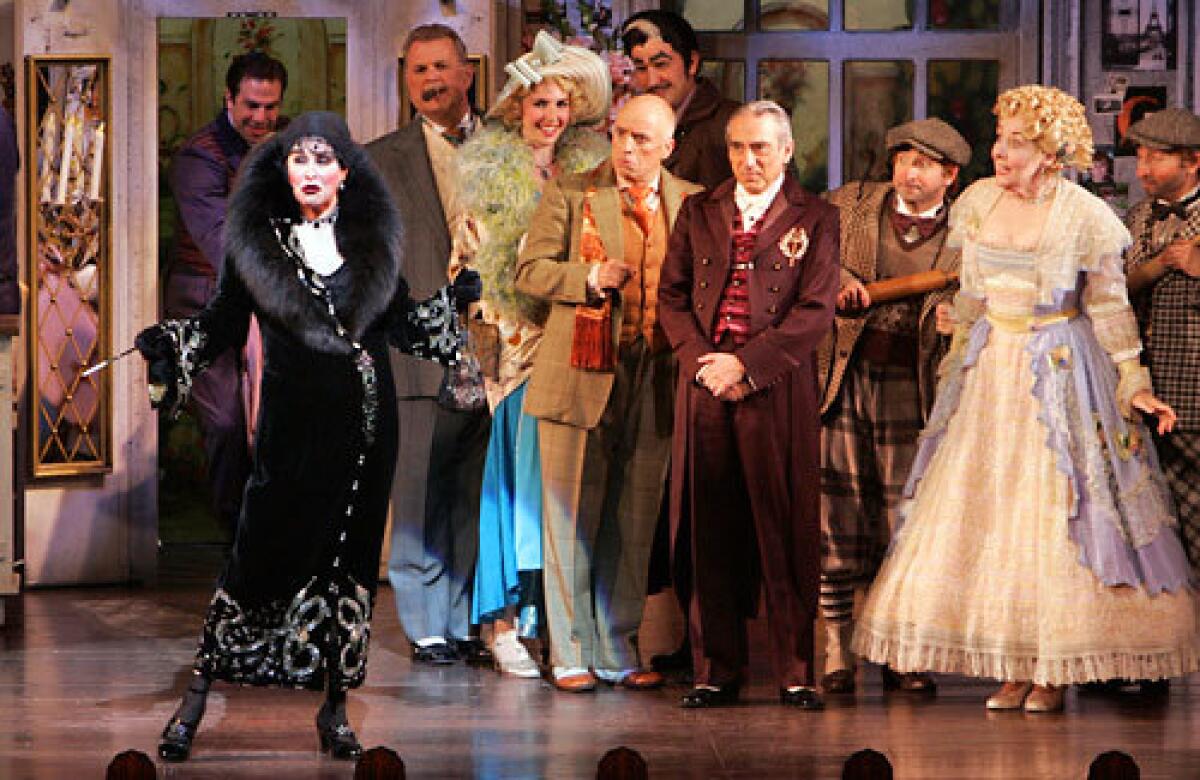‘The Drowsy Chaperone’ at the Ahmanson Theatre

- Share via
Well, he’s still sitting alone in his room, listening to his original cast albums play. The answering machine light isn’t blinking, the apartment could use some sprucing up, and that old cardigan he’s wearing is looking a little ratty. But you have to admit there’s something heartwarming about the sight of someone who knows his pleasure and sticks to it.
I’m speaking, of course, about Man in Chair, the mopey, middle-aged theater buff of “The Drowsy Chaperone,” back at the Ahmanson Theatre, where it had its U.S. premiere in 2005 before venturing to Broadway and winning a slew of Tonys. It’s always nice to pay a visit to the lonely apartment where the sounds of Broadway yesteryear blare. But if you’re wondering why the show has returned so soon in a touring production that is, in all its principal replacements, noticeably inferior to the original, the only thing I can come up with is that there was a need for some lighthearted summer fare with name recognition.
So be it. I’m happy to recommend “Drowsy” as a beach musical, if you’ll allow for such a category. The show is charming and imaginative in the most untaxing ways. And though the current cast lacks the original polish, the colorfulness of Casey Nicholaw’s frolicsome staging has a temporary mood-lifting effect -- an important consideration for those like our protagonist who turn to musicals as others turn to Prozac.
Especially exciting to Man in Chair (played here by Jonathan Crombie) are the forgotten shows from the Jazz Age that aren’t by Kern, Gershwin or Porter -- in other words, the pleasurable, brainless trifles that would have otherwise slipped into a void were it not for self-appointed librarians like him. “The Drowsy Chaperone” is the title of the screwy 1928 romantic musical he eagerly wants to share with us -- the unfortunate denizens of a theatrical time that in his opinion has gone to the Elton John dogs.
As the music starts and his spirits rise, our storyteller’s residence (vividly assembled by David Gallo in all its Salvation Army detail) is transformed into a welcoming stage for the imaginary cast to re-create the old fatuous razzle-dazzle of this pretend relic. And naturally, given the period, what emerges is a series of cotton-candy revue skits strung out on the zaniest and most inconsequential of plots.
“But that’s what musicals are all about, right?” Man in Chair exclaims. “Romantic fantasy. Falling in love at the drop of a hat! Spontaneous tango-ing. Suddenly finding yourself in an insanely romantic setting!”
No surprise the guy hates the way intermissions “yank you back into reality.” It’s escapism he’s after, pure and simple, an alternative to a world that rarely works out, an antidote to the inevitable blues.
Although the playful setup doesn’t dramatically deepen in any satisfying way, the character of Man in Chair, with his fanatic enthusiasms, questionable taste and wry commentary, is so cleverly introduced that he generates goodwill. And a good thing too, for the musical within the musical, though it has a couple of sparkling numbers, has always seemed to me like champagne that has been stored too long in the fridge.
The score by Lisa Lambert and Greg Morrison sets out to conjure the blissful musical inanity of the era, but the pastiche has an evanescent quality that’s positively amnesia-inducing.
The only song with any real staying power is “Show Off,” which provides a frisky opportunity for the young diva Janet Van De Graaff (Andrea Chamberlain) to showcase the variety-show talents she’s giving up to become a bride. Originally performed by the incomparable Sutton Foster, it was the musical’s one bona fide showstopper. Chamberlain, who understudied the role on Broadway, gives a solid understudy facsimile of the magic, which is no slight to her. She’s bright and able -- she’s just no Sutton Foster.
Where comparison is most invidious, however, is with Crombie’s Man in Chair. The role was tailor-made for Bob Martin, who co-wrote the book with Don McKellar, and what was once convincingly inhabited is now being oh-so-campily acted. Martin knew who this sexually ambiguous loner was, even if we never did, and that private assurance is missing in Crombie’s signboarded portrayal.
Still, even with a new chaperone who mugs and a substitute groom who looks like he has wandered into the wrong wedding, the show has a madcap breeziness that can bring a fleeting smile to a warm summer night.
More to Read
The biggest entertainment stories
Get our big stories about Hollywood, film, television, music, arts, culture and more right in your inbox as soon as they publish.
You may occasionally receive promotional content from the Los Angeles Times.











